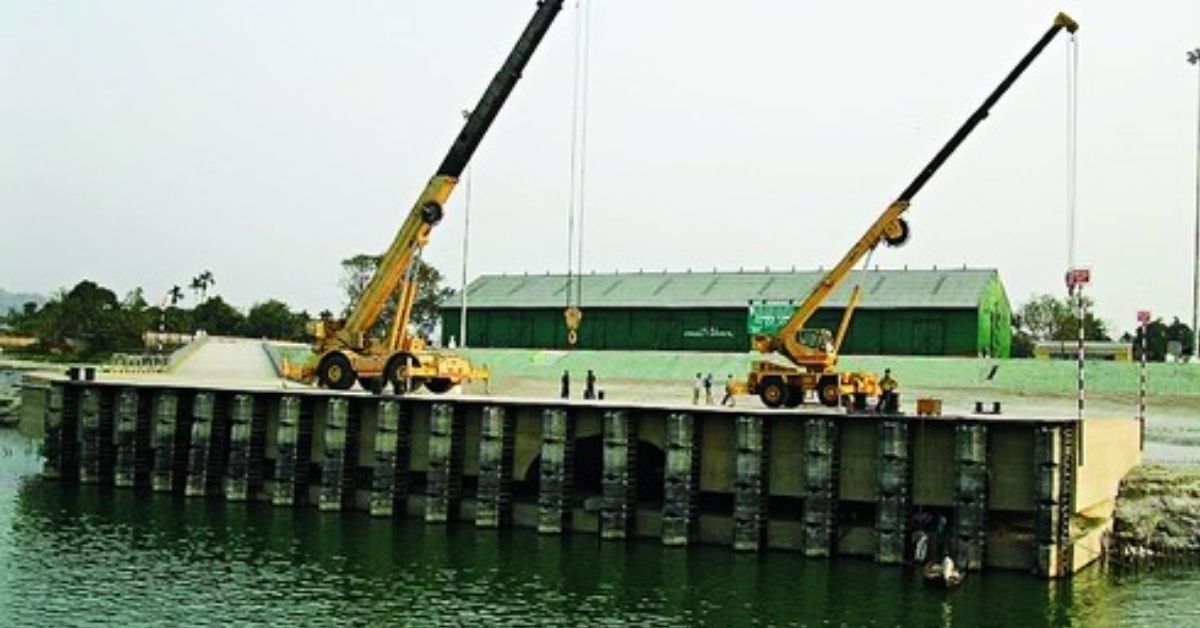Pandu (Guwahati) is the most important location on National Waterways (NW-2) (river Brahamputra) and accordingly Government established a Multi-Modal river port at Pandu. Government has approved a project for development of NW-2 at a cost of Rs. 461 cr during 2020-21 to 2024-25. Establishment of a ship repair facility at Pandu at a cost of Rs. 72.6 cr is one of the component of the project. Development of Ship repair facility at Pandu is beneficial since North Eastern Region (NER) does not have any vessel repair facility with dry docking. At present, the vessels in the NER are taken to Kolkata through Bangladesh for dry dock repair.
A master plan was therefore prepared for phased development of terminal at Pandu and development was carried out accordingly. A low-level jetty at a cost of 40.02 crores was made operational in 2009. A high level jetty at a cost of 43.89 crores was also made operational during 2014-15 for round the year operation with mechanical handing facility including containers.
i. A broad gauge railway siding connecting Pandu port to Kamakhya railway station (Guwahati) has been constructed through NF Railway at a cost of 16.46 crore and opened for commercial operation by NF Railway in 2013. IWAI has signed the Agreement with NF Railway for using the BG Siding for movement of Cargo by third party.
ii. Fairway development works: To improve the connectivity between NW-1 and NW-2/NW-16 via the Indo Bangladesh protocol route, the critical and shallow stretches between Sirajganj and Daikhowa on protocol route No1 & 2 and Ashuganj and Zakiganj on protocol rote no 3 &4in Bangladesh are being jointly developed by India and Bangladesh for round the year navigability (with targeted LAD of 2.5 mtrs). Similarly, fairway development works are being carried out on NW-97 in Sunderbans to allow smooth navigation of vessels on the Indo-Bangladesh Protocol Route.
iii. Revision of Levy & Collection of Fees: Taking ahead the vision of the Government of India to promote Inland Waterways as a supplementary mode of transport, the Ministry of Ports, Shipping and Waterways has considered waiver of waterway user charges initially for a period of three years.
iv. Enhanced regional trade using IWT mode:
a. Addition of new Ports of Call and routes in India and Bangladesh under PIWT&T: With 7 new ports of call in addition to existing 6 on each side along with addition/ extension of 2 waterway routes in addition to existing 8 routes under PIWT&T between India and Bangladesh, the accessibility of IWT mode for trade between India and Bangladesh is expected to increase and result in growth of traffic on NWs.
b. Trade between Bhutan and Bangladesh: Stone exporters from Bhutan have identified Inland waterways as an alternate mode of transportation considering the benefits associated with waterways mode such as lower transportation cost, larger shipment size compared to road, avoiding congestion on land routes etc. The first movement under supervision of IWAI was successfully executed in July 2019. This trade using the IWT mode is expected to continue and reach a significant scale in the coming years.
v. Standard Operating Procedures (SOPs) for facilitating the Stakeholders to use Inland Water Transport and access the various information related to National Waterways
The list of Standard Operating Procedures (SOPs) for various National Waterways which are available at IWAI website is as given below:
a. Standard Operating Procedures (SOP) of the Agreement on the use of Chattogram and Mongla Ports for movement of goods to and from India between the Government of the People’s Republic of Bangladesh and the Government of Republic of India.
b. Standard Operating Procedures (SOP) of MoU on Passenger and Cruise Services on the Coastal and Protocol Route between the Government of the People’s Republic of Bangladesh and the Government of Republic of India.
c. Standard Operating Procedures (SOP) for the MoU on use of Inland Waterways for Transportation of Bilateral Trade and Transit cargoes between the Government of People’s Republic of Bangladesh and the Government of Republic of India.
d. Standard Operating Procedures (SOP) for the Movement of Vessels on Protocol on Inland Water Transit and Trade (PIWT&T) to contain the spread of COVID19.
e. Standard Operating Procedures (SOP) and Check List for Ro-Ro / Ro-Pax vessel operations on National Waterways.
f. Standard Operating Procedures (SOP) for Car-D Portal.
vi. Stakeholder consultations: IWAI carried out stakeholder consultations at six different locations (Kolkata, Kochi, Mumbai, Patna, Goa and Dhaka) in FY-20 and 9 conference-cum-webinars during FY-21. These interactions helped in promoting waterways as a mode of transportation and understanding expectations and feedback of stakeholders. IWAI is undertaking targeted initiatives to address the expectation and feedback received to further enhance traffic on NWs.







